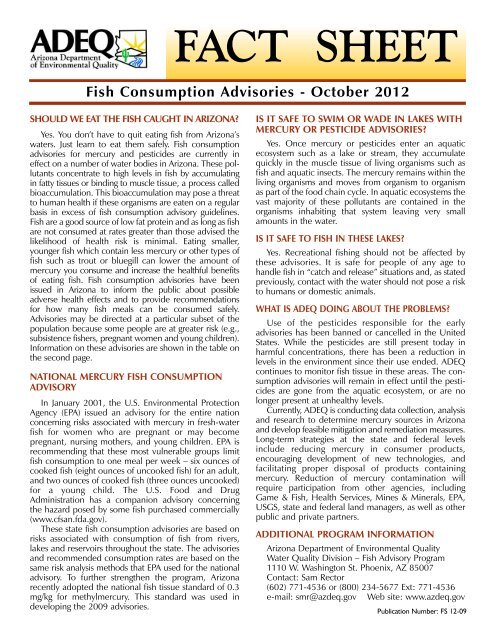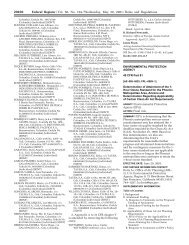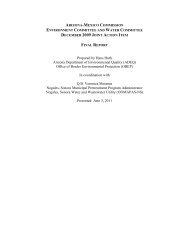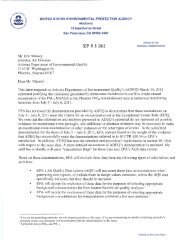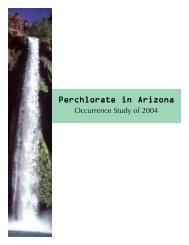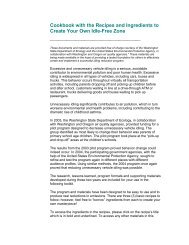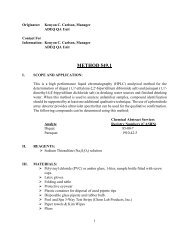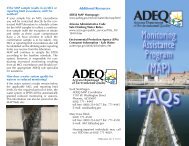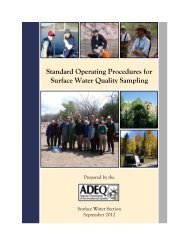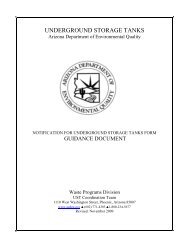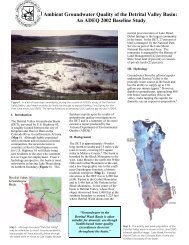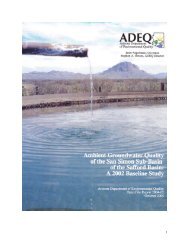Fish Consumption Advisories - Arizona Department of ...
Fish Consumption Advisories - Arizona Department of ...
Fish Consumption Advisories - Arizona Department of ...
You also want an ePaper? Increase the reach of your titles
YUMPU automatically turns print PDFs into web optimized ePapers that Google loves.
FACT SHEET<br />
<strong>Fish</strong> <strong>Consumption</strong> <strong>Advisories</strong> - October 2012<br />
SHOULD WE EAT THE FISH CAUGHT IN ARIZONA?<br />
Yes. You don’t have to quit eating fish from <strong>Arizona</strong>’s<br />
waters. Just learn to eat them safely. <strong>Fish</strong> consumption<br />
advisories for mercury and pesticides are currently in<br />
effect on a number <strong>of</strong> water bodies in <strong>Arizona</strong>. These pollutants<br />
concentrate to high levels in fish by accumulating<br />
in fatty tissues or binding to muscle tissue, a process called<br />
bioaccumulation. This bioaccumulation may pose a threat<br />
to human health if these organisms are eaten on a regular<br />
basis in excess <strong>of</strong> fish consumption advisory guidelines.<br />
<strong>Fish</strong> are a good source <strong>of</strong> low fat protein and as long as fish<br />
are not consumed at rates greater than those advised the<br />
likelihood <strong>of</strong> health risk is minimal. Eating smaller,<br />
younger fish which contain less mercury or other types <strong>of</strong><br />
fish such as trout or bluegill can lower the amount <strong>of</strong><br />
mercury you consume and increase the healthful benefits<br />
<strong>of</strong> eating fish. <strong>Fish</strong> consumption advisories have been<br />
issued in <strong>Arizona</strong> to inform the public about possible<br />
adverse health effects and to provide recommendations<br />
for how many fish meals can be consumed safely.<br />
<strong>Advisories</strong> may be directed at a particular subset <strong>of</strong> the<br />
population because some people are at greater risk (e.g.,<br />
subsistence fishers, pregnant women and young children).<br />
Information on these advisories are shown in the table on<br />
the second page.<br />
NATIONAL MERCURY FISH CONSUMPTION<br />
ADVISORY<br />
In January 2001, the U.S. Environmental Protection<br />
Agency (EPA) issued an advisory for the entire nation<br />
concerning risks associated with mercury in fresh-water<br />
fish for women who are pregnant or may become<br />
pregnant, nursing mothers, and young children. EPA is<br />
recommending that these most vulnerable groups limit<br />
fish consumption to one meal per week – six ounces <strong>of</strong><br />
cooked fish (eight ounces <strong>of</strong> uncooked fish) for an adult,<br />
and two ounces <strong>of</strong> cooked fish (three ounces uncooked)<br />
for a young child. The U.S. Food and Drug<br />
Administration has a companion advisory concerning<br />
the hazard posed by some fish purchased commercially<br />
(www.cfsan.fda.gov).<br />
These state fish consumption advisories are based on<br />
risks associated with consumption <strong>of</strong> fish from rivers,<br />
lakes and reservoirs throughout the state. The advisories<br />
and recommended consumption rates are based on the<br />
same risk analysis methods that EPA used for the national<br />
advisory. To further strengthen the program, <strong>Arizona</strong><br />
recently adopted the national fish tissue standard <strong>of</strong> 0.3<br />
mg/kg for methylmercury. This standard was used in<br />
developing the 2009 advisories.<br />
IS IT SAFE TO SWIM OR WADE IN LAKES WITH<br />
MERCURY OR PESTICIDE ADVISORIES?<br />
Yes. Once mercury or pesticides enter an aquatic<br />
ecosystem such as a lake or stream, they accumulate<br />
quickly in the muscle tissue <strong>of</strong> living organisms such as<br />
fish and aquatic insects. The mercury remains within the<br />
living organisms and moves from organism to organism<br />
as part <strong>of</strong> the food chain cycle. In aquatic ecosystems the<br />
vast majority <strong>of</strong> these pollutants are contained in the<br />
organisms inhabiting that system leaving very small<br />
amounts in the water.<br />
IS IT SAFE TO FISH IN THESE LAKES?<br />
Yes. Recreational fishing should not be affected by<br />
these advisories. It is safe for people <strong>of</strong> any age to<br />
handle fish in “catch and release” situations and, as stated<br />
previously, contact with the water should not pose a risk<br />
to humans or domestic animals.<br />
WHAT IS ADEQ DOING ABOUT THE PROBLEMS?<br />
Use <strong>of</strong> the pesticides responsible for the early<br />
advisories has been banned or cancelled in the United<br />
States. While the pesticides are still present today in<br />
harmful concentrations, there has been a reduction in<br />
levels in the environment since their use ended. ADEQ<br />
continues to monitor fish tissue in these areas. The consumption<br />
advisories will remain in effect until the pesticides<br />
are gone from the aquatic ecosystem, or are no<br />
longer present at unhealthy levels.<br />
Currently, ADEQ is conducting data collection, analysis<br />
and research to determine mercury sources in <strong>Arizona</strong><br />
and develop feasible mitigation and remediation measures.<br />
Long-term strategies at the state and federal levels<br />
include reducing mercury in consumer products,<br />
encouraging development <strong>of</strong> new technologies, and<br />
facilitating proper disposal <strong>of</strong> products containing<br />
mercury. Reduction <strong>of</strong> mercury contamination will<br />
require participation from other agencies, including<br />
Game & <strong>Fish</strong>, Health Services, Mines & Minerals, EPA,<br />
USGS, state and federal land managers, as well as other<br />
public and private partners.<br />
ADDITIONAL PROGRAM INFORMATION<br />
<strong>Arizona</strong> <strong>Department</strong> <strong>of</strong> Environmental Quality<br />
Water Quality Division – <strong>Fish</strong> Advisory Program<br />
1110 W. Washington St. Phoenix, AZ 85007<br />
Contact: Sam Rector<br />
(602) 771-4536 or (800) 234-5677 Ext: 771-4536<br />
e-mail: smr@azdeq.gov Web site: www.azdeq.gov<br />
Publication Number: FS 12-09
Waterbody / Date Issued Advised <strong>Consumption</strong> Rates (based on uncooked portion)<br />
Pollutant <strong>of</strong> Concern<br />
Alamo Lake - Mercury<br />
Arivaca Lake - Mercury<br />
Coors Lake - Mercury<br />
Dysart Drain<br />
(a canal that drains to the Agua<br />
Fria River in the Phoenix area)<br />
- banned pesticides<br />
Lake Pleasant - Mercury<br />
Lake Powell- Mercury<br />
Lyman Lake - Mercury<br />
Painted Rocks Reservoir<br />
Painted Rock Borrow Pit Lake,<br />
and portions <strong>of</strong> the Gila, Salt,<br />
and Hassayampa rivers<br />
- banned pesticides<br />
Parker Canyon Lake - Mercury<br />
Peña Blanca Lake - Mercury<br />
Roosevelt Lake - Mercury<br />
Tonto Creek<br />
(downstream <strong>of</strong> the northern<br />
boundary <strong>of</strong> Hellsgate<br />
Wilderness at Bear Flat<br />
Campground) - Mercury<br />
Soldier Lake<br />
Soldier Annex Lake and<br />
Long Lake - Mercury<br />
Upper and Lower Lake Mary<br />
- Mercury<br />
February<br />
2004<br />
1996<br />
February<br />
2004<br />
1995<br />
January<br />
2009<br />
October<br />
2012<br />
October<br />
2002<br />
1991<br />
October<br />
2002<br />
1995<br />
January<br />
2009<br />
July 2011<br />
July 2003<br />
May 2002<br />
Pregnant women and children under the age <strong>of</strong> 16: No consumption <strong>of</strong> largemouth bass, black crappie, or channel catfish<br />
Women <strong>of</strong> childbearing age: One 8 oz fish meal per month <strong>of</strong> largemouth bass, black crappie, or channel catfish<br />
Adult women past childbearing age and men older than 16 yrs: Four 8 oz fish meals per month <strong>of</strong> largemouth bass or<br />
black crappie. Six 8 oz fish meals per month for channel catfish<br />
Do not consume fish and other aquatic organisms<br />
Pregnant women and children under the age <strong>of</strong> 16: No consumption <strong>of</strong> largemouth bass<br />
Women <strong>of</strong> childbearing age: One 8 oz fish meal per month <strong>of</strong> largemouth bass<br />
Adult women past childbearing age and men older than 16 yrs: Four 8 oz fish meals per month <strong>of</strong> largemouth bass<br />
Do not consume fish and other aquatic organisms<br />
Pregnant women and children under the age <strong>of</strong> 6: No consumption <strong>of</strong> largemouth bass<br />
Women <strong>of</strong> childbearing age and children between the ages <strong>of</strong> 6 and 16: One 8 oz fish meal per month <strong>of</strong> largemouth bass<br />
Adult women past childbearing age and men older than 16 yrs: Five 8 oz fish meals per month <strong>of</strong> largemouth bass<br />
Pregnant women and children under age <strong>of</strong> 6: One 4 oz meal per month <strong>of</strong> striped bass<br />
Women <strong>of</strong> childbearing age and children between 6 and 16 years <strong>of</strong> age: Two 8 oz meals per month <strong>of</strong> striped bass<br />
Adult women past childbearing age and men older than 16: eight 8 oz fish meals per month <strong>of</strong> striped bass<br />
Pregnant women and children under age <strong>of</strong> 6: No consumption <strong>of</strong> walleye, largemouth bass or channel catfish<br />
Children between the ages <strong>of</strong> 6 and 16: no consumption <strong>of</strong> walleye or largemouth bass; one 8 oz fish meal per month <strong>of</strong><br />
channel catfish<br />
Women <strong>of</strong> childbearing age: One 8 oz. fish meal per month <strong>of</strong> walleye, largemouth bass or channel catfish<br />
Adult women past childbearing age and men older than 16 yrs: Three 8 oz fish meals per month <strong>of</strong> walleye and largemouth<br />
bass; five 8 oz fish meals per month <strong>of</strong> channel catfish<br />
Do not consume fish and other aquatic organisms<br />
Pregnant women and children under age <strong>of</strong> 6: No consumption <strong>of</strong> largemouth bass, bluegill or pike<br />
Children between the ages <strong>of</strong> 6 and 16: no consumption <strong>of</strong> largemouth bass; one 8 oz fish meal per month <strong>of</strong> bluegill or pike<br />
Women <strong>of</strong> childbearing age: One 8 oz fish meal per month <strong>of</strong> largemouth bass or bluegill; two 8 oz fish meals per month<br />
<strong>of</strong> pike<br />
Adult women past childbearing age and men older than 16 yrs: Three 8 oz fish meals per month <strong>of</strong> largemouth bass; five 8 oz<br />
fish meals per month <strong>of</strong> bluegill; six 8 oz fish meals per month <strong>of</strong> pike<br />
Do not consume fish and other aquatic organisms<br />
Pregnant women and children under the age <strong>of</strong> 6: No consumption <strong>of</strong> largemouth bass or channel catfish.<br />
Women <strong>of</strong> childbearing age and children between the ages <strong>of</strong> 6 and 16: One 8 oz fish meal per month <strong>of</strong> largemouth bass or<br />
channel catfish<br />
Adult women past childbearing age and men older than 16 yrs: Five 8 oz fish meals per month <strong>of</strong> largemouth bass or<br />
channel catfish<br />
Do not consume smallmouth bass, green sunfish and black bullhead catfish<br />
For common carp in this area:<br />
Pregnant women and children under the age <strong>of</strong> 6: No consumption<br />
Children between six and sixteen years <strong>of</strong> age: One 8 oz. fish meal/month<br />
All adults (16 years or older): Two 8 oz. fish meals per month<br />
Do not consume any fish caught from these lakes<br />
Do not consume walleye fish.<br />
Limit consumption <strong>of</strong> all other fish species to one 8 oz fillet per month


